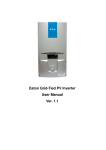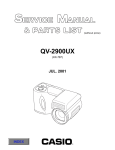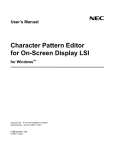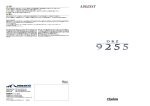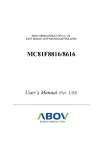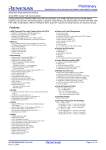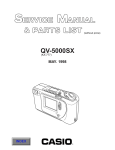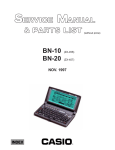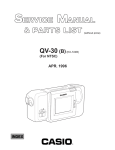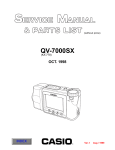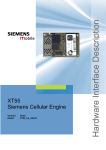Download Casio QV-770 Specifications
Transcript
(without price) QV-770 (KX-773) APR. 1998 INDEX R CONTENTS SPECIFICATIONS ......................................................................................................................................1 BLOCK DIAGRAM .....................................................................................................................................2 ADJUSTMENT ...........................................................................................................................................3 1-1. Loading color parameter ................................................................................................................3 1-2. Defect correct ..................................................................................................................................4 1-3. Strobe adjust ...................................................................................................................................4 1-4. Strobe check ...................................................................................................................................5 1-5. Display appearance when using flash. ......................................................................................... 7 1-6. Current consumption .....................................................................................................................7 1-7. IrDA Test ..........................................................................................................................................7 1-8. Test program ...................................................................................................................................8 1. Standard test program (including QV-770 Built in ROM) ........................................................8 2. Special test program (including QV-770 Built in ROM) ......................................................... 12 Battery check ............................................................................................................................12 Key check ..................................................................................................................................13 Last memory set .......................................................................................................................13 2. Adjustment of PCB-DA .................................................................................................................... 14 Adjustment of VCC7, VCC3, voltage check of VCC1 ....................................................................15 Operation Check ..............................................................................................................................15 3. Adjustment of PCB-L .......................................................................................................................16 VCC3, VCC5 voltage check LA-PCB ..............................................................................................17 VCC2 adjustment and VCC7, VCC8, VEE2 voltage check ...........................................................17 VCO free run frequency adjustment ..............................................................................................17 BL drive voltage adjustment ........................................................................................................... 18 VCOM AC adjustment and VCOM DC coarse adjustment ............................................................18 Bright voltage setting and contrast adjustment (PCB-LA) ..........................................................19 Color adjustment (PCB-LA) ............................................................................................................19 TINT adjustment ...............................................................................................................................20 DISASSEMBLY ........................................................................................................................................21 EXPLODED VIEW .................................................................................................................................... 26 PARTS LIST ............................................................................................................................................. 28 PRINTED CIRCUIT BOARDS .................................................................................................................. 33 SCHEMATIC DIAGRAMS ........................................................................................................................37 TROUBLE SHOOTING ............................................................................................................................43 SPECIFICATIONS Item Recording System Specification Digital (JPEG base); PC Link software can be used to input images in CAM, JPEG, TIFF and other format. Signal System NTSC Recording Medium Flash memory (4 MB) Memory Capacity FINE; 30 images (Approx. 124 KB compressed) NORMAL; 60 images (Approx. 62 KB compressed) ECONOMY; 120 images (Approx. 32 KB compressed) Imaging Element 1/4-inch CCD (Total Pixels: 350,000; Effective Pixels: 330,000) Lens Fixed focal point with macro position; F2, f = 3.9 mm Focus Range NORMAL: 70 cm to ∞ MACRO: 14 cm to 16 cm (From surface of protective lens) Light Metering TTL center priority by CCD Exposure Metering Program AE, Aperture Priority AE Exposure Range EV +5 to 18 Exposure Correction –2 EV to +2 EV (1/4 EV units) Shutter CCD shutter Shutter Speed 1/8 to 1/4000 second White Balance Automatic, Fixed Self-timer 10 seconds Flash Modes Auto Flash, Flash On, Flash Off Resolution Modes FINE, NORMAL, ECONOMY Monitor/Viewfinder 1.8” TFT, low-glare color LCD (122,100 pixels) Computer output image 640 × 480 pixels Input/Output Terminals DIGITAL OUT, VIDEO OUT, AC adaptor connector Clock January 1, 1997 00:00:00 to December 31, 2049 11:59:59 (Auto calendar) Power Supply Four batteries (AA-size alkaline or lithium batteries) /AC adaptor (AD-C620) Power consumption Approximately 6.8 W Battery Life Continuous Playback: Alkaline Batteries (LR6); Approx. 190 minutes Lithium Batteries (FR6); Approx. 320 minutes Continuous Recording: Alkaline Batteries (LR6); Approx. 690 shots Lithium Batteries (FR6); Approx. 1,430 shots Note: The values noted above indicate the number of hours before battery failure under normal operating temperature (25 °C), as estimated by battery manufacturers. These values are for reference only, and do not guarantee that any particular set of batteries actually will provide the service life indicted. Low temperatures shorten battery life. Dimensions 129(W) × 66(H) × 38(D) mm Weight Approximately 200 g Accessories Wrist strap, soft case, Alkaline batteries (AA-size × 4), Video cord —1— BLOCK DIAGRAM KB–PCB KA–PCB LED 6-pin CA–PCB 3.5V T.G BR9040F delete Vdr V 3.3V IrDA CCDCS AD0 EPCS 15.0V CCDPS AD1 EPRB -5.5V MCK32 AD2 EPSK 5.0V MCK AD3 EPDI 3.3V WEN AD4 IRISA AGND SCK AD5 IRISB DGND SD0 AD6 MAC1 HR1 AD7 FR1 AD8 CCDRST AD9 CAGC VCC3-2(CPU controlled CLPOB 3.3V) YUV Processor CXD3120R Motor Drive 3.3V OSD 3.3V Video 3.1V VIDEO Signal Generator RS232C RS232C Auto Iris Lens INTR —2— 3.3V 15.0V - 5.5V 5.0V Battery Voltage 5-pin IRIS+ IRISMAC1 Vcc3-2 GND 18-pin Strobe Ass'y Battery voltage High Voltage Generator Xe Lamp Photo Sensor MB91181 Controller 20-pin Solenoid ROM uPD6461 CXD2450R 3.3V Photo INT 3.3V EDO_DRAM 3.3V EEPROM 27-pin 3.3V 15V -5.5V DA–PCB 3.3V CDS+AGC CCD LED KEY2 3.3V GND 6-pin 3.3V GND FLASH/M_MEMORY CXD2310A1 optional 3.3V3.3 3.3V ADC CXA2096N 3.3V ICX098AK 15V KEY0 KEY1 PON Comparator 6.0V Battery voltage PLAYB SCH BL RTSW PW PW0 VIDEO VCC5 VCC3 VCCA VCC DGND GND LA–PCB STRG SCHG SCEND SECNT SCSEL 5V GND 2-pin AC_ADP 7-pin 5V Voltage Controller Voltage Controller 3.3V 5.0V 13.5V 7.5V 5.0V -15.0V 3.0V 6.0V 5-pin Transformer FUNC key (PLAYB) BL LB–PCB 6.0V 14-pin 5V, 7.5V Detection SW (RSTW) BLA–PCB, BLB–PCB BL1 NC GND NC BL2 IR3Y29BM Chroma VCC0 FRP VCC2 PLAYB VR VEE2 VG VCC8 VB GND CSYNC HDB COD18T1016 *** 27-pin 3V Display Controller (CM7018) VSH MLCK VDD HCNT VR CLR VG OE VB SRTL VSS SRTR MODE1 VBC CS VGL VCOM VREFH MODE2 VGH RESET GSRT GP CK VREFL LCD module VSH : 5.0V VGH : 13.5V VGL : -15.0V VDD : 3.0V VSS : GND ADJUSTMENT 1-1. Loading color parameter Execute when replacing camera unit Load parameter in memory of camera unit. (Light box not needed.) (1) Set QV-770 to “PLAY” mode. (Computer communication does not work in “REC” mode.) (2) Connect QV-770 and PC with link cable RS-232. (3) Operate adjustment software on MS-DOS. PON773E. EXE (4) Make sure PC’s monitor indicates that loading parameter is complete. Note: When done continue the program in the following order. 1. DEFECT CORRECT 2. STROBE ADJUST *********************************** * Prameter Installer * * for KX-773 * * Ver 1.60 * *********************************** [NG] (example 1) Display when Failure occurs. [OK] Loading Parameter to Flash Memoty....OK. Verifying data.....OK. Adjustment complete. *** Time Out Error *** [NG] (example 2) Verify error unable to load parameter. Check camera. Notes: • When NG is displayed check connections and settings. • Use AC adapters. To Link cable RS-232C port To digital terminal QV-770 PC —3— 1-2. Defect correct When there is a blurred black dot in a white display it is called a defect. To correct this use the data next to this. • Perform this adjustment after loading color parameters. (1) (2) (3) (4) (5) Set QV-770 to “REC” mode. Start test program. (Refer to “1-8. Test program”.) Choose “DEFECT CORRECT” from test program and execute. Make sure “ ” mark on LCD turns from red to blue. Turn power off. Notes: • Make sure no light goes through CCD. • As the adjustment data is written in the EEPROM by the POWER switch operation, do not forget to turn it off using the switch. • Pixel compensations are performed up to two pixel defects. • The compensation data is deleted once you exit the mode. AD-C620 QV-770 Block CCD completely from light. 1-3. Strobe adjust Execute after replacing strobe and loading color parameter, because strobe adjustment informations are deleted. • Loading color parameter and Defect correct should be done before. • Distance between strobe lens and gray paper should be one meter. • The adjustment must be done in a dark room. • For gray paper use Superior Oxford Gray No.22. (Note: Use lighter color surface of the paper.) • The two sizes listed below are available as spare parts. (Can also found in camera store.) Code No. Name Specification 1904 5411 Gray paper of Superior Oxford No.22 (1.75 × 2.7 m) 1904 5412 Gray paper of Superior Oxford No.22 (2.72 × 11 m) • For power supply use AC adapter. (1) (2) (3) (4) (5) (6) Set QV-770 to “REC” mode. Start test program. (Refer to “1-8. Test program”.) Choose “Strobe adjust” from test program and execute. Shoot a picture of a specified gray paper. Flash icon should be red before shooting. Make sure that the flash icon on LCD turns from red to blue. Turn power off. Note: As the adjustment data is written in the “EEPROM” by the “POWER” switch operation, do not forget to turn it off using the switch. —4— LCD Strobe icon er et 1 m Gr ay pa pe r ✽ Gray paper should be larger than 1.5 m (H) × 2.0 m (W). 1-4. Strobe check Checking if there is a false operation triggered by a distorted waveform when using strobe. • Set strobe adjustment. • Input DC in 6.0 ± 0.1 V. (1) Set QV-770 to “REC” mode. (2) Monitor the trigger waveform on digital oscilloscope and check the display. (3) Automatically recharged after shooting picture. Make sure that the DC in 6.0 V current does not exceed 1.2 A. (4) Set QV-770 to “PLAY” mode and check the display. Should not be white or too dark. A Ammeter Voltage Regulator DC6.0±0.1V TIME: 1.0 µsec/DIV VOLTS: 1V/DIV (AC) Digital oscilloscope • Put oscilloscope probe on Camera unit. • Earth of the probe should be hooked as shown above. ✽ If it is NG, make sure the wiring of strobe circuit. —5— Strobe trigger waveform 1. Normal waveform CH1 TIME : 1 µ sec/DIV VOLTS : 1 V/DIV 1V 1µV 757µV UERT First positive pulse. OK if second positive pulse is shown. First negative pulse. ACQUIRE NORMAL 1 ENVELOPE 2 AVS REPET SAVE ON ON | OFF ON | OFF 2. NG waveforms when trigger skipping occurs. (1) When trigger skipping occurs on the first positive pulse. (2) When trigger skipping occurs on the first negative pulse. —6— 1-5. Display appearance when using flash. (1) (2) (3) (4) Shoot picture with Normal F2. Shoot picture with Normal F8. Shoot picture with Macro mode Normal F8. Set QV-770 to “PLAY” mode and check the display. Notes: • (1) and (2) should look alike. (3) should be darker than (2). • (1) and (2) should not be white or too dark. • QV-770 and test chart (Material that does not reflect) should be 70 cm apart. Strobe lens Test chart 70 cm Monitor QV-770 Superior Oxford Gray No.22 1-6 Current consumption • Input DC in = 6.0 V ± 0.1 V. (1) Set QV-770 to “REC” mode. Maximum current consumption: 525 mA (Not including re-charge of strobe) Example: Maximum current consumption in “PLAY” mode: 371 mA (2) Reducing the input voltage from 6V, make sure that the battery warning changes at 5.0V ± 0.1 V input. 1-7 IrDA Test (1) Make sure no sunlight comes in. (2) Make sure there are no inverter light around. (3) Use black cloth to cover jig. After making the adjustments above make sure communication is possible at ± 15° and distance of 50 cm. (Refer to User’s Manual for the infrared transport.) QV-770 X 50 × COS (75) × –3.5 × 2 8.5 Y 50 × SIN (75) 48.0 IrTP sensor Y 48 cm 50cm IrTP sensor 75° QV-770 It must be 48 cm apart and lined up pararell. Make sure that TRANP communication is possible. X : Distance between camera case edges. Y : Distance in straight line. X 8.5 cm —7— 1-8. Test program Classified 1. Standard test program 1. 2. 3. 4. 5. 6. 7. 8. 9. 10. 11. 10STEP COLOR BAR CROSS HATCH 50 PER. WHITE RASTER GRAY RASTER CLACK APO OFF IR TEST MASTER IR TEST SLAVE SEND ENQ TEST RECEIVE ENQ TEST 2. Special test program 1. 2. 3. 4. 5. STOROBE ADJUST DEFECT CORRECT BATTERY CHECK KEY CHECK LAST MEMORY SET 1. Standard test program (including QV-770 Built in ROM) (1) Turn power on while pressing “DISP” and “SHUTTER” buttons. (2) “WELCOME!” appears on the display followed by TEST MODE display. TEST MODE 98030401 ADJ01.60 PTPXX.XX ROM version ADJ version patch soft version (3) Press “MENU” button and “Tran.P” button simultaneously to display the standard test program menu. 10 STEP COLOR BAR CROSS HATCH 50PER. WHITE RASTER GRAY RASTER BLACK APO OFF IR TEST MASTER IR TEST SLAVE SEND ENQ TEST RECEIVE ENQ TEST (4) Press “–” and “+” buttons to select. Press “SHUTTER” button to execute the test. —8— —9— (1) Transaction (2) Display (3) Check (4) Supplement 1. 10-step black and white display Displays black and white bar gradated in 11 steps Displays 10-step black and white bar on the LCD and TV monitor Utilized for brightness voltage and contrast adjustment on PCB-L. When checking with an oscilloscope, terminate it with 75 ohm resistance. Returns to Test mode display by [+] or [–] buttons. 2. Color bar display Provides color bar signal to the LCD and TV monitor (displays 75 % white level VIDEO signal) Displays color bar on the LCD and TV monitor Make sure that white level 75% color bar is outputted from VIDEO OUT terminal. When checking with an oscilloscope, terminate it with 75 ohm resistance. Returns to Test mode display by [+] or [–] buttons. 3. Cross hatch display Provides cross hatch signal to LCD and TV monitor (displays white line mesh on black display) Displays cross hatch on LCD and TV monitor 4. 50 percent white raster display Provides brightness 50 % gray signal to LCD and TV monitor. Used for VCOM DC adjustment on PCB-L. Displays brightness 50% gray color on LCD and TV monitor. 5. Gray raster display Provides brightness 50 % gray signal to LCD and TV monitor Displays brightness 50% gray color on LCD and TV monitor. When checking with an oscilloscope, terminate it with 75 ohm resistance. Returns to Test mode display by [+] or [–] buttons. Refer to page 18 for VCOM DC adjustment on PCB-L. When checking with an oscilloscope, terminate it with 75 ohm resistance. Returns to Test mode display by [+] or [–] buttons. When checking with an oscilloscope, terminate it with 75 ohm resistance. Returns to Test mode display by [+] or [–] buttons. (1) Transaction (2) Display (3) Check (4) Supplement 6. Black color display Provides black signal to LCD and TV monitor (Black level of VIDEO standard) Displays black on LCD and TV monitor. Returns to Test mode display by [+] or [-] buttons. 7. APO OFF display Disables Auto Power Off function. This function can be utilized in REC or PLAY modes. Normal REC or PLAY modes The unit returns to normal mode when power switch is turned off. — 10 — 8. IR TEST MASTER Used for IrDA test together with IR TEST SLAVE. This display test sends ENQ (OX ø5) signal for 2 seconds with 10ms interval (115Kbps data transfer speed). FACTORY TEST MASTER ACTIVE FACTORY TEST MASTER Immediately after selecting IR TEST MASTER and pressed the shutter button. When the unit received ENQ signal. OK SUCCESS FACTORY TEST MASTER When the unit received a signal other than ENQ. NG FACTORY TEST MASTER NG TIMEOUT If there is no answer for 2 seconds. Make sure that the display indicates OK. This mode is disabled when the unit is turned off. (1) Transaction 9. IR TEST SLAVE display Used for IrDA test together with IR TEST MASTER. This test sets the camera in standby mode to receive data. When the unit receives data, it sends back the data with 115Kbps transfer speed. — 11 — 10. SEND ENQ TEST display Used for IrDA test together with RECEIVE ENQ TEST. This test continuously sends ENQ (OXø5) signal with 10ms intervals (115Kbps) 11. RECEIVE ENQ TEST display Used for IrDA test together with SEND ENQ TEST. In this mode, the unit becomes receive standby status. When the unit receives a data, it discriminates if the data is ENQ signal. OK counter counts up when the unit receives 10 ENQ signals and NG counter counts up when the unit receives other signals than ENQ. (2) Display FACTORY TEST SLAVE ACTIVE (3) Check (4) Supplement The unit does not show any change on the display since this is subsidiary mode for IR TEST MASTER. This mode is disabled when the unit is turned off. The data transfer result is shown on the reception unit. This mode is disabled when the unit is turned off. IRDA SELECT MENU SEND OK NG 00000 00000 Discriminate the receiving operation by counting OK or NG counts. This mode is disabled when the unit is turned off. 2. Special test program (including QV-770 Built in ROM) (1) Turn power on at REC mode, then press “Mode” button twice and change to “Serial Recording mode” then turn power OFF. (2) Turn power on while pressing “DISP“ button and “SHUTTER” button. (3) “WELCOME!” appears on the display followed by TEST MODE display. TEST MODE 98030401 ADJ01.60 PTPXX.XX ROM version ADJ version patch soft version (4) Press “MODE” button twice, then press “MENU” button and “Tran-P” button simultaneously to display the special program menu. STROBE ADJUST DEFECT CORRECT BATTERY CHECK KEY CHECK LAST MEMORY SET (5) Press “–” button and “+” to select. Press “SHUTTER” button to execute the test. Note: • Refer to “1-3. Strobe adjust”. • Refer to “1-2. Defect correct”. Battery check • Used when measuring battery life. (1) After selecting Battery check set intervals for taking pictures. (Maximum 30 seconds) (2) Press shutter button to enter “REC” mode. In this you can select Flash, or flash off or flash AUTO. TOTAL SHOT 1 Number of pictures taken. Notes: • TOTAL SHOT numbers will not remain in memory. (When batteries go dead they are deleted). • Timers stop while WAIT is displayed. (1 shot takes 10 seconds). Does not mean 6 shots in one minute. Actually about 5.5 shots in one minut. — 12 — Key check • Displays “Digital” values for key input. 20TIMES KEY SAMOLING INTERVALS OF 10MS PUSH ANY KEY!! NO KEY 000 000 000 000 000 000 000 000 000 000 000 000 000 000 000 000 000 000 000 000 Note: • Number on display should be reference. Last memory set • Set last memory value to default. LAST MEMORY COMPLETE ! ! DISP MODE ON LAST PAGE 1PAGE AUTOPLAY TIME 3SEC VGA TYPE NORMAL STORBE MODE AUTO REC CONTINIOUS CONT.S REC SELF-TIMER SIGGLE SCREEN SAVER ON PLEASE POWER OFF ! ! (1) When power is turned on, make sure the display as shown above. Note: • Even when you follow the command, the picture remains in memory. — 13 — 2. Adjustment of PCB-DA Adjustment points of PCB-K773-DA — 14 — Adjustment of VCC7, VCC3, voltage check of VCC1 • Supply voltage CP150 = 5.0 ± 0.05 [V] CP130 = 3.3 ± 0.05 [V] CP100 = 5.0 ± 0.05 [V] (You can use an AC adaptor however, for the checking after repairs, apply above mentioned voltages.) (1) Adjust VR131 for VCC7(CP121) to be 15.0 ± 0.3 V (2) Adjust VR130 for VEE3(CP120) to be –5.5 ± 0.1 V (3) Make sure that VCC1(CP102) is 3.2 ± 0.16 V Operation Check • Supply voltage CP150 = 5.0 ± 0.05 [V] CP130 = 3.3 ± 0.05 [V] CP100 = 5.0 ± 0.05 [V] (You can use an AC adaptor however, for the checking after repairs, apply above mentioned voltages.) 1. Set QV-770 to “PLAY” mode. (Computer communication does not work in “REC” mode.) 2. Connect QV-770 and PC with link cable. 3. Operate adjustment software on MS-DOS. T773E. EXE 4. Make sure PC’s monitor indicates that loading parameter is complete. (1) (2) (3) (4) (5) (6) (7) (8) (9) (10) (11) (12) (13) Make sure that serial communication is OK. Make sure DRAM is OK. Make sure flash memory is OK. Make sure OSD is OK. Make sure Battery Voltage warning level is OK. (value 164 to 243) Make sure color bar is outputted. Make sure backlight controller is OK. Make sure LED controller is OK. Check key input. Make sure VIDEO SW controller is OK. Make sure each button is OK. Make sure IrDA is OK. Make sure to turn power OFF. — 15 — 3. Adjustment of PCB-L (PCB-LA/PCB-LB) Adjustment points of PCB-K773-LA Adjustment points of PCB-K773-LB — 16 — VCC3, VCC5 voltage check PCB-LA • Voltage supply CP151 = 5.0 ± 0.05 V. (You can use an AC adaptor however, for the checking after repairs, apply above mentioned voltages.) (1) Apply 5.0 ± 0.05 V to CP150. (2) Make sure VCC3 (CP160) is 3.3 ± 0.1 V and VCC5 (CP152) is 5.0 ± 0.15 V. VCC2 adjustment and VCC7, VCC8, VEE2 voltage check • Voltage supply VCL0(CP101)=5.0±0.05V. (You can use an AC adaptor however, for the checking after repairs, apply above mentioned voltages.) (1) Apply 5.0 V ± 0.05 V to VCL0 and adjust VR100 so that VCC2 will be 5.0 ± 0.02 V. Notes: • VCC7 = 7.3 ~ 8.3 [V], VCC8 = 12.0 ~ 14.0 [V] • VEE2 = –12.3 ~ –16.7 [V] In addition, disconnect the power and make sure all output voltages are 0 V. VCO free run frequency adjustment • Voltage supply VCC2=5 V ± 0.05 (V) (CP181). VCC8 = 13.5 ± 0.05 (V) (CP180). VEE2 = –15.0 ± 0.05 (V) (CP182). Connect CP705 (CSY) and CP700 (GNP). (You can use an AC adaptor however, for the checking after repairs, apply above mentioned voltages.) (1) Monitoring CP710 (HDB) with a frequency counter, adjust VR720 so that the frequency will be 15.734 ± 0.1 [KHz]. Notes: • Disconnect CP705 and CP700, then connect PCB-LA and make sure CP705 (CSY) and CP710 (HDB) are synchronized. • Keep room temperature at 20 ± 10°C. QV-770 PCB-LB VCC2 Power suppry VCC8 VEE2 (CP181) CSY (CP180) (CP182) CS (CP705) CSY (CP705) HDB (CP710) oscilloscope HDB frequency counter PCB-LA PCB assy — 17 — BL drive voltage adjustment • Voltage supply VCL0 (CP101)=5.0±0.05[V] Apply 3.3 V ± 5% to PW. (You can use an AC adaptor however, for the checking after repairs, apply above mentioned voltages.) (1) Apply 5.0 ± 0.05 V to VCL0 and adjust VR900 so that CP901(VBL) will be 6.1 ± 0.1 V. Notes: • Make sure that the current consumption is not abnormally large. • CN920 is open. QV-770 PCB-LA VCL0 A (CP101) VBL (CP901) Power suppry 3.3 V V PW VCOM AC adjustment and VCOM DC coarse adjustment (PCB-LB) • Voltage supply VCC2 = 5 V ± 0.05 (V) (CP181). VCC8 = 13.5 ± 0.05 (V) (CP180). VEE2 = –15.0 ± 0.05 (V) (CP182). (You can use an AC adaptor however, for the checking after repairs, apply above mentioned voltages.) (1) Make sure that the amplitude of VCOM output (CP771) is 6.6 ± 0.3 V. (2) Adjust VR770 so that the potential of VCOM output (CP711) will be 4.8 ± 0.2 V. QV-770 PCB-LB VCC8 Power suppry VCC2 VEE2 high level 4.8 [V] 0 [V] –1.8 [V] (CP180) (CP181 VCOM (CP182) (CP771) — 18 — oscilloscope amplitude 6.6 [V] Bright voltage setting and contrast adjustment (PCB-LA) • Signal contents 10STEP (NTSC) Input oscillation level 0.5 Vp-p to VIDEO terminal (CP302). • Voltage supply VCL0 (CP101)=5 V ± 0.05 (V). Apply 3.3 V± 5% to PW. Connect PCB-LB and input. (You can use an AC adaptor however, for the checking after repairs, apply above mentioned voltages.) (1) Adjust VB waveform (CP324) as shown below by triggering FRP (CP305) signal. (2) Adjust waveform A at 3.5 ± 0.05 V by adjusting RGB, AMP VR(VR302). (3) Adjust contranst terminal voltage (CP306) at 1.5V ± 0.05V by adjusting contrast VR (VR303). (4) Keep waveform B at 2.1 ± 0.05V by adjusting Bright VR (VR304). (5) Keep waveform C at 2.9 ± 0.05V by adjusting contrast VR (VR303). Note: • Make sure that waveforms are not distorted. 2.1 V QV-770 PCB-LA PW SG Waveform C (CP101) (CP302) VB (CP324) Waveform B Waveform A 2.9 V Power suppry VCL0 3.5 V 3.3 V VIDEO (0.5 Vp-p) osilloscope Color adjustment (PCB-LA) • Signal contents Input oscillation level 0.5 Vp-p to VIDEO terminal (CP302). • Set Power Supply VCL0 (CP101) to 5.0 ± 0.05 V. Apply 3.3 V ± 5% to PW. Input HDB signal by connecting PCB-LB. (You can use an AC adaptor however, for the checking after repairs, apply above mentioned voltages.) (1) Adjust VR300 so that the first and fourth pulses of VB(CP324) signal will be the same. Notes: • Perform this adjustment after contrast adjustment. • Trigger FRP (CP305) QV-770 3.3 V PCB-LA 1 2 3 4 PW Power suppry SG VCL0 (CP101) VB (CP324) (CP302) oscilloscope VIDEO (0.5 Vp-p) — 19 — TINT adjustment • Signal contents Input oscillation level 0.5 Vp-p to VIDEO terminal (CP302). • Set power supply VCL0 (CP101) to 5.0 ± 0.05V. Apply 3.3 V ± 5 % to PW. Input HDB signal by connecting PCB-LB. (You can use an AC adaptor however, for the checking after repairs, apply above mentioned voltages.) (1) Adjust VR301 so that the second and third pulses of VB (CP324) signal level will be the same. Notes: • Perform this adjustment after contrast adjustment. • Trigger FRP (CP305). QV-770 3.3 V PCB-LA 1 2 3 4 PW Power suppry SG VCL0 (CP101) VB (CP324) (CP302) oscilloscope VIDEO (0.5 Vp-p) — 20 — DISASSEMBLY Numbers in the parethesis correspond to the numbers in EXPLODED VIEW. 1. Unscrew two screws (S1) on the bottom of the camera. two screws (S1) 2. Rotate the camera unit and unscrew two screws (S1). Open console cover (2), then unscrew two screws (S1). two screws (S1) two screws (S1) 3. Separate upper case (14) and lower case (25). Remove console (2) and battery cover (41). — 21 — 4. Disconnect two flexible cables from PCB-DA ass’y and remove two connectors from PCB-L ass’y. D k flexible cable connector 5. Disassembly of upper case. Remove flexible cable from PCB-L ass’y, then remove SUB773-LB2 ass’y. flexible cable Unscrew four screws (S2) fixing PCB-L ass’y then remove it. four screws (S2) — 22 — Unscrew three screws (S2) fixing backlight, then remove the backlight. three screws (S2) When assembling, make sure to put each sheet in order. diffusion sheet (10) filter sheet (9) LCM spacer (8) Remove two screws (S2) fixing PCB-K773-KB ass’y (20), then remove PCB-K773-KB ass’y (20). two screws (S2) Remove LCD (6). When assembling, make sure reverse side of the LCD is free from dust. — 23 — 6. Disassembly of Main case. Unscrew two screws (S4) fixing camera unit, then remove camera unit. two screws (S4) Remove PCB-K773A-KA (43). Unscrew two screws (S4) fixing PCB-K773-DA ass’y (24), then remove PCB-K773-DA ass’y (24). two screws (S4) — 24 — 7. Disassembly of Camera Unit. Unscrew one screw (S1), then disassemble as shown. one screw (S1) When assembling convex part of CCD should be placed with concave part of F knob. convex part concave part Unscrew one screw (S3) and disconnect two flexible cables, them remove CCD unit. one screw (S3) — 25 — EXPLODED VIEW 27 29 39 40 30 31 28 S3 38 33 32 38 37 33 S2 S3 34 36 S3 35 S3 S1 38 — 26 — S1 15 S4 S1 7 S4 18 17 12 13 26 S4 16 S4 14 24 44 20 S2 19 11 S2 6 S4 22 8 2 9 3 43 10 S1 25 23 S1 21 S1 S2 41 S2 S1 S2 1 5 S2 4 — 27 — S2 S2 42 PARTS LIST DIGITAL PCB ASS'Y Item IC507 IC508 IC400 IC582 IC530 IC550 IC515 IC150 IC531 IC502 IC503 IC131 IC510 IC580 IC590 IC586 IC588 IC500 IC560 IC584 IC130 IC540 IC505 JK510 JK515 Q515 Q134 Q169 Q520 Q522 Q130 Q133 Q521 Q588 Q508 Q510 Q131 Q132 Q507 Q511 Q539 Q580 Q583 D130 D132 D131 D510 D513 H500 H502 VR130 VR131 Code No. Parts Name Specification ICs 2012 5747 IC MB81V16165B50LPFTN 2012 4347 IC TC58V32FT 2114 5808 IC CXD3120R 2105 3633 IC TC7S00FU-TE85L 2116 0119 IC BA10358F-T1 2105 6398 IC LB1846M-TE-L 2105 6378 IC MM1228XFBE 2114 5806 IC TK11232BMCL 2105 6361 IC XC61AC2402MR 2114 5810 IC S-80930ALMP-DAT-T2 2114 5810 IC S-80930ALMP-DAT-T2 2105 5999 IC XC6383F501MR 2105 5712 IC TC7S04FU(TE85L) 2105 2170 IC TC4S66F-TE85L 2105 5719 IC TC7W32FU(TE12L) 2105 3521 IC TC7S08FU(TE85L) 2105 5215 IC TC7W74FU(TE12L) 2114 5838 IC MB91181PBT-G 2114 5839 IC RPM851-E4 2114 5817 IC S-80936ANMP-DD0-T2 2114 5607 IC TK11830MTL 2012 5950 IC UPD6466GS-514-E1 2012 6054 IC LH5G85T0 JACKS 3501 8197 JACK HSJ1169-019010 3501 5439 JACK HSJ1456-01-210 TRANSISTORS 2254 0448 FET/CHIP 2SK1580-T1 2253 0434 TRANSISTOR/CHIP 2SD1328-T(TX) 2259 2716 TRANSISTOR/CHIP 2SC4617-TLR 2259 2716 TRANSISTOR/CHIP 2SC4617-TLR 2259 2716 TRANSISTOR/CHIP 2SC4617-TLR 2251 0847 TRANSISTOR/CHIP 2SB1386-T100R 2250 1579 TRANSISTOR/CHIP 2SA1774-TLR 2250 1579 TRANSISTOR/CHIP 2SA1774-TLR 2250 1579 TRANSISTOR/CHIP 2SA1774-TLR 2259 2731 TRANSISTOR/DIGITAL DTA114EE-TL 2259 2731 TRANSISTOR/DIGITAL DTA114EE-TL 2259 2715 TRANSISTOR/DIGITAL DTC144EE-TL 2259 2715 TRANSISTOR/DIGITAL DTC144EE-TL 2259 2715 TRANSISTOR/DIGITAL DTC144EE-TL 2259 2715 TRANSISTOR/DIGITAL DTC144EE-TL 2259 2715 TRANSISTOR/DIGITAL DTC144EE-TL 2259 2715 TRANSISTOR/DIGITAL DTC144EE-TL 2259 2715 TRANSISTOR/DIGITAL DTC144EE-TL DIODES 7101 1194 DIODE/CHIP MA111-(TX) 7101 1194 DIODE/CHIP MA111-(TX) 2390 1379 DIODES/SCHOTTKY/CHIP MA729-(TX) 2390 1379 DIODES/SCHOTTKY/CHIP MA729-(TX) 2390 1379 DIODES/SCHOTTKY/CHIP MA729-(TX) OSCILLATORS 2590 2720 OSCILLATOR DSX840GA-23.9M 2590 2736 OSCILLATOR CX-11F-14.3M VARIABLE RESISTORS 2775 1491 RESISTOR/SEMI-FIXED EVM-1XSX50B54 2775 1491 RESISTOR/SEMI-FIXED EVM-1XSX50B54 Notes: Q – Quantity used per unit R – Rank — 28— Applicable Q R 1 1 1 1 1 1 1 1 1 1 1 1 1 1 1 1 1 1 1 1 1 1 1 C C C C C C C C C C C C C C C C C C C C C C C 1 C 1 C 1 1 1 1 1 1 1 1 1 1 1 1 1 1 1 1 1 1 C C C C C C C C C C C C C C C C C C 1 1 1 1 1 C C C C C 1 C 1 C 1 C 1 C LINEAR PCB ASS'Y Item IC545 IC150 IC300 IC160 IC900 IC920 IC100 SW150 Q950 Q160 Q100 Q900 Q300 Q543 Q541 Q540 Q101 Q102 Q150 Q151 Q901 D110 D111 D113 D101 D112 D150 D900 D160 T100 T900 FU152 FU150 FU151 VR300 VR301 VR304 VR302 VR303 VR100 VR900 H300 JK100 Code No. Parts Name Specification ICs 2105 6425 IC 2105 3374 IC 2114 5840 IC 2114 5841 IC 2114 5842 IC 2105 6463 IC 2105 6464 IC SWITCH 3412 2002 SWITCH TRANSISTORS 2253 0700 FET/CHIP 2114 5807 FET/CHIP 2253 0308 TRANSISTOR/CHIP 2253 0308 TRANSISTOR/CHIP 2253 0133 TRANSISTOR/CHIP 2259 2716 TRANSISTOR/CHIP 2251 0926 TRANSISTOR/CHIP 2250 1579 TRANSISTOR/CHIP 7101 5791 TRANSISTOR/CHIP 2259 2715 TRANSISTOR/CHIP 2259 2715 TRANSISTOR/CHIP 2259 2715 TRANSISTOR/CHIP 2259 2715 TRANSISTOR/CHIP DIODES 7101 1194 DIODE/CHIP 7101 1194 DIODE/CHIP 7101 1194 DIODE/CHIP 2390 2450 DIODE/CHIP 2390 1379 DIODES/SCHOTTKY/CHIP 2390 1379 DIODES/SCHOTTKY/CHIP 2390 1379 DIODES/SCHOTTKY/CHIP 2390 1379 DIODES/SCHOTTKY/CHIP CONVERTER & TRANSFORMER 3065 0713 CONVERTER/DC-DC 3012 1176 TRANSFORMER/INVERTER FUSES 3632 0732 FUSE 3632 0724 FUSE 3632 0724 FUSE VARIABLE RESISTORS 2775 1484 RESISTOR/SEMI-FIXED 2775 1484 RESISTOR/SEMI-FIXED 2775 1484 RESISTOR/SEMI-FIXED 2775 1491 RESISTOR/SEMI-FIXED 2775 1491 RESISTOR/SEMI-FIXED 2775 1505 RESISTOR/SEMI-FIXED 2775 1505 RESISTOR/SEMI-FIXED OSCILLATOR 2590 1239 OSCILLATOR JACK 3501 6755 JACK/POWER Notes: Q – Quantity used per unit R – Rank Applicable Q R XC61AN3802MR RS5RM5045A-T1 IR3Y29BM R1220V332B-E2 S-8327E50MC-EKE-T2 TC7ST02FU-TE85L XC6371F453PR 1 1 1 1 1 1 1 SPVC2-1-T 1 C 2SK1485-T1 SI3441DV-T1 2SD1119-R(TX) 2SD1119-R(TX) 2SD1819A-R(TX) 2SC4617-TLR 2SB1412TLQ 2SA1774-TLR DTA144EE-TL DTC144EE-TL DTC144EE-TL DTC144EE-TL DTC144EE-TL 1 1 1 1 1 1 1 1 1 1 1 1 1 C C C C C C C C C C C C C MA111-(TX) MA111-(TX) MA111-(TX) SC016-2-TE12RA MA729-(TX) MA729-(TX) MA729-(TX) MA738-(TX) 1 1 1 1 1 1 1 1 C C C C C C C C 6CA-02 ETJ-09K002AM 1 C 1 C KE25 KE13 KE13 1 1 1 A A A EVM-1XSX50B24 EVM-1XSX50B24 EVM-1XSX50B24 EVM-1XSX50B54 EVM-1XSX50B54 EVM-1XSX50B55 EVM-1XSX50B55 1 1 1 1 1 1 1 C C C C C C C HC-49/U-S-A 1 C HEC3600-010120 1 C — 29— C C C C C C C SUB LINEAR PCB ASS'Y Item SW700 IC770 IC700 IC780 D700 D721 D720 VR770 VR720 Code No. Parts Name SWITCH 3412 1106 SWITCH/SLIDE ICs 2114 5805 IC 2012 5983 LSI 2105 4501 IC DIODES 7101 1194 DIODE/CHIP 2360 3060 DIODE/ZENER/CHIP 2390 1358 DIODE/VARICAP VARIABLE RESISTORS 2775 1827 RESISTOR/SEMI-FIXED 2775 1484 RESISTOR/SEMI-FIXED Specification Applicable Q R SSSS212-12 1 B NJM3414AV-TE1 CM7018L3-T4N RN5RL30AA-TR 1 C 1 C 1 C MA111-(TX) MA8100-H(TX) MA329-(TX) 1 C 1 C 1 C EVM-1XSX50B13 EVM-1XSX50B24 1 C 1 C TOP KEY PCB ASS'Y Item Code No. Parts Name SW800 SW801 SW802 SW803 SW804 SW805 SWITCHES 3412 2002 3412 1995 3412 1995 3412 1995 3412 1995 3412 1995 SWITCH SWITCH SWITCH SWITCH SWITCH SWITCH Specification Applicable SPVC2-1-T SKQRAA-T SKQRAA-T SKQRAA-T SKQRAA-T SKQRAA-T Q R 1 1 1 1 1 1 C C C C C FRONT KEY PCB ASS'Y Item SW806 SW807 SW808 Q800 D800 Code No. Parts Name SWITCHES 3412 1995 3412 1995 3412 1995 TRANSISTOR 7911 0126 LED 2370 1396 Notes: Specification Applicable Q R SWITCH SWITCH SWITCH SKQRAA-T SKQRAA-T SKQRAA-T 1 C 1 C 1 C TRANSISTOR/DIGITAL DTC144EUA-T106 1 C LED SLC-22DU3F 1 C Q – Quantity used per unit R – Rank — 30— MAIN BODY CONPONENT Item Code No. 1 2 3 4 5 6 7 8 9 10 11 12 13 14 15 16 17 18 19 20 21 22 23 24 25 26 27 28 29 30 31 32 33 34 35 36 37 38 39 40 41 42 43 44 S1 S2 S3 S4 6612 9180 6612 9250 6612 9350 6612 9540 6613 0020 2725 1347 6612 9220 6612 9310 6612 9320 6612 9330 6611 4390 6611 4410 6612 6160 6612 9110 6612 9140 6612 9190 6612 9200 6612 9370 6612 9580 6613 0039 6613 0040 6613 0037 6612 9210 6613 0750 6613 0041 6613 0042 6612 9430 6612 9440 6612 9451 6612 9460 6612 9470 1014 9857 1014 9858 6612 9160 6612 9170 6612 9270 6612 9410 6612 9530 6613 0060 6613 0070 6613 0035 6613 0012 6612 9099 6612 9430 5861 3692 5860 0301 5861 3690 5860 0091 Notes: Parts Name Specification GRIP COVER/CN LABEL/COVER CABLE/FLAT PCB ASSY/LINEAR MODULE/LCD BUTTON/FRONT SPACER/LCM SHEET/FILTER SHEET/DIFFUSION SCREW/FOR STAND SPRING PLATE/EARTH CASE/UPPER PANEL/DP KNOB/POWER KNOB/REC TAPE/DOUBLE SIDE CUSHION PCB ASSY/KEY/FRONT BL ASSY HOLDER ASSY/BATTERY BUTTON/TOP PCB ASSY/DIGITAL CASE/LOWER CASE/CAMERA KNOB/FOCUS LEVER/FOCUS PROTECTOR/LENS COVER/SENSOR PANEL/LENS CL UNIT STROBE UNIT CASE/SIDE STOPPER SPRING/C CASE/CAM B CABLE CASE/CAM COVER/PROTECTOR BATTERY COVER PCB ASSY/LINEAR/SUB PCB ASSY/KA/TOP PLATE/RATING SCREW SCREW SCREW SCREW Q – Quantity used per unit R – Rank K340982-1 K240813-1 K441321-1 K441330-1 K341115*1 COD18T1022RN K340986-1 K441256-1 K441257-1 K441258-1 R340024-1 R440045-1 R440256-1 K140419-1 K240809-1 K340983-1 K340984-1 K441334-1 K441337-1 K441366*1 K341120*1 K341121*1 K340985-1 K341271*1 K240905*1 K240912*1 K340996-1 K340997-1 K441262A-1 K441263-1 K341018-1 LS-025D CA-KX-773 K240811-1 K240812-1 K441253-1 K240817-1 K240793-1 K140421-1 K240818-1 K341119*1 K140464*2 K441465*1 K441282-1 PS3 FLAT1.7X4 NI BT3 BIND 1.7X3.5 NI BT3 BIND 1.7X4.0 BK BT3 BIND 1.7X4.5 BK — 31— Applicable Q R 1 1 1 1 1 1 1 1 1 1 1 1 1 1 1 1 1 1 1 1 1 1 1 1 1 1 1 1 1 1 1 1 1 1 1 1 1 1 1 1 1 1 1 1 7 10 4 6 X C X X B B C X C C X X X X C C C X X C B B C B X X C C X X X B B X X X X X X X B B C X C C C C ACCESSORY Item Code No. 45 46 47 1014 9871 5861 3578 1014 8773 Notes: Parts Name Specification CASE/SOFT STRAP CORD/VIDEO Applicable SC-773 ST-K775 VC-K723-FC 47 46 — 32 — R 1 X 1 X 1 X Q – Quantity used per unit R – Rank 45 Q PRINTED CIRCUIT BOARDS D board (PCB-K773A-DA) — 33 — L board (PCB-K773A-LA) — 34 — L board(PCB-K773A-LB) CA board (PCB-K773A-CA) — 35 — K board (PCB-K773A-KA) (PCB-K773A-KB) — 36 — SCHEMATIC DIAGRAMS DA-CIR-K0773AAA — 37 — LA-CIR-K0773AAA — 38 — LB-CIR-ZK0773AAA — 39 — KX-CIR-ZK0773AAA — 40 — KA-CIR-K0773AAA — 41 — KB-CIR-K0773AAA — 42 — TROUBLE SHOOTING Trouble 1 : No display • LCD connector or BL connector is OPEN. → Insert connector. If broken, replace it. Trouble 2 : Erratic display when using strobe. • Interruption when using strobe. → Refer to “1-4. Strobe check”. Trouble 3 : Cannot switch between REC/PLAY. • Broken slide switch of PCB-L ass’y or improper assemble. → Replace switch or re-assemble. Trouble 4 : Short battery life. • Refer to User’s Manual (P15, 16, 75). → Varies depending on manufacturer, kind of battery, temperature, storage period. The time specified in user’s manual is generalization and is not guaranteed. Trouble 5 : When switching from PLAY to REC LCD display turns blue and key input does no work. (Unable to turn power off) • Faulty connection between PCB-DA ass’y and camera unit or camera unit failure. → Reconnect connector or replace either L case ass’y or CL unit or CAM case unit. Trouble 6 : Faulty display (not using strobe). • Bad connector connection between PCB-DA ass’y and camera unit. → Reconnect the connector. • EEPROM data error. → Operate color parameter. • Camera unit failure. → Replace CL unit or CAM case unit. — 43 — CASIO TECHNO CO.,LTD. Overseas Service Division 8-11-10, Nishi-Shinjuku Shinjuku-ku, Tokyo 160-0023, Japan














































